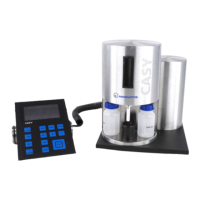
Do you have a question about the OLS CASY TT and is the answer not in the manual?
| Data Interface | USB, Ethernet |
|---|---|
| Power Requirements | 100-240 V AC, 50/60 Hz |
| Measurement Principle | Electrical Current Exclusion |
| Sample Types | bacteria |
| Analysis Time | Typically < 60 seconds |
| Viability Measurement | Yes, with dye exclusion method |
| Applications | Cell counting, cell viability, cell size distribution |
| Dimensions (W x D x H) | 30 cm x 40 cm x 25 cm |
| Weight | Approx. 10 kg |
| Concentration Range | Up to 10^7 cells/mL (depending on particle size and type) |
| Software Compatibility | Windows-based software |
Records changes made to the document over time.
Provides contact information for the manufacturer and distributors.
States compliance with relevant EU directives and standards.
Outlines the terms and conditions of the product warranty.
Lists registered trademarks of the company and others.
Specifies the purpose and application scope of the instrument.
Explains text and symbol conventions used throughout the manual.
Details safety guidelines for operating and handling the device.
Provides instructions for the proper disposal of the equipment.
Describes the capabilities and features of the CASY Cell Counter and Analyzer.
Explains the underlying technology used for cell analysis.
Details the method for measuring cell viability.
Explains the process for correcting cell counts due to aggregation.
Briefly introduces the CASY TT instrument's features and ergonomics.
Describes the components and functions of the main measuring unit.
Details the structure and replacement of these key components.
Explains the role of these systems in instrument operation.
Describes the layout and functions of the user interface.
Provides criteria for selecting an optimal installation site.
Instructs on connecting the instrument and its accessories correctly.
Explains the procedure for powering the instrument on and off.
Outlines the steps to ready the system before taking measurements.
Details the regular cleaning procedure to ensure optimal performance.
Describes surface cleaning of instrument parts.
Provides instructions for shutting down the system for extended periods.
Introduces the instrument's operation via control keys.
Explains navigation through the system's main menu.
Describes how to choose and load pre-defined measurement settings.
Details how to modify and save measurement parameters.
Explains how to switch between different measuring capillaries.
Describes how to configure the system's date and time settings.
Covers system-wide configurations and graph parameter settings.
Outlines diagnostic and system maintenance functions.
Provides guidelines for sample preparation before measurement.
Explains how to perform a measurement and interpret results.
Details the format and meaning of numerical output data.
Lists important considerations for accurate measurements.
Guides on adjusting parameters for optimal data analysis.
Explains how to manually adjust cursors for analysis.
Describes methods for exporting measurement data.
Introduces common error codes and general troubleshooting steps.
Provides solutions for high background noise issues.
Offers steps to resolve concentration-related errors.
Guides on clearing capillary blockage errors.
Details how to address air bubble detection issues.
Explains troubleshooting for fluid system errors.
Addresses errors related to valve issues.
Covers troubleshooting for dark or light display problems.
Explains steps if the instrument calibration is lost.
Guides on resolving real-time clock errors.
Offers solutions for inconsistent measurement results.
Explains discrepancies between CASY and hemocytometer counts.
Troubleshoots issues with data export to CASY excell.
Describes the process of transferring data via a serial connection.
Lists the specifications and technical details of the instrument.